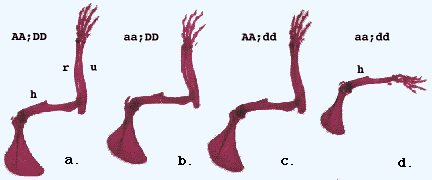The five most 5' paralogous groups (Hox 9-13) pattern the posterior region of the vertebrate embryo and the appendicular skeleton. Mice with targeted disruptions in the paralogous genes hoxa-11 and hoxd-11 have been generated by Davis et all [1995] to evaluate the role of the genes in determining the body plan. Breeding these two strains together generated double mutants which have dramatic phenotypes: the radius and the ulna of the forelimb are almost entirely eliminated, the axial skeleton shows homeotic transformations.
In this picture from Mario Capecchi's lab at the University of Utah, you can see the effects of mutating two of the three genes from one paralogous group in the mouse HOX cluster. These pictures show the forelimb bones from mice with mutations in two genes from the Hox-11 group.

The capitol letters 'A' and 'D' represent a normal copy of the HOX A-11 or HOX D-11 genes. The small letters 'a' and 'd' represent a mutated copy of these genes. For each picture, the genotype of the animal at these two genes is shown (i.e. aa; DD indicates a mouse that was mutant at both copies of the HOX A-11 gene and normal at both copies of the HOX D-11 gene).
(a) is a normal limb. The letters h, r, u indicate the three main bones of the forelimb: r=radius, u=ulna, h=humerus.
(b) shows the type of limb observed when both copies of HOX A-11 are mutant, and both copies of HOX D-11 are normal.
(c) shows the type of limb observed when both copies of HOX D-11 are mutant, and both copies of HOX A-11 are normal.
Note that the structure and arrangement of the bones in (b) and (c) are both approximately normal. Therefore, mutation at a single gene in this paralogous group has a relatively mild effect on the animal.
(d) shows the type of limb observed when both copies of both genes are mutated.
Note that two of the forelimb bones, the radius and ulna, are almost completely missing. A striking change in body shape has occurred due to double mutation at the HOX A-11 and D-11 genes.
[Davis AP; Witte DP; Hsieh-Li HM; Potter SS; Capecchi MR; Nature 375: 791-5 (1995)]
Strong's Luxoid (1stD) is a semidominant mouse mutation in which heterozygotes show preaxial hindlimb polydactyly, and homozygotes show fore- and hindlimb polydactyly. The digit patterns of these polydactylous limbs resemble those caused by polarizing grafts, since additional digits with posterior character are present at the anterior side of the limb. Such observations suggest that 1stD limb buds might contain a genetically determined ectopic region of polarizing activity.
[Chan DC; Laufer E; Tabin C; Leder P; Development 121: 1971-8 (1995)]
The positional signaling along the anteroposterior axis of the developing vertebrate limb is provided by the zone of polarizing activity (ZPA) located at the posterior margin. Recently, it was established that the Sonic hedgehog (Shh) mediates ZPA activity. New Recombination induced mutant 4 (Rim4), and two old mutants, Hemimelic extra toes (Hx) and Extra toes (Xt), exhibit mirror-image duplications of the skeletal pattern of the digits. All results indicate the presence of an additional ZPA at the anterior margin of limb buds in these mutants.
[Masuya H et al.; Genes Dev 9: 1645-53 (1995)]
HOX Genes &Tetrapods Limbs Abnormalities
Organization Of Vertebrate Network Of Hox Genes And Limb Fate Map